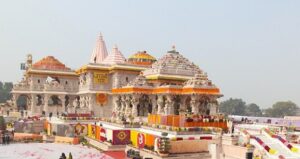
The Ram Temple in Ayodhya stands as a symbol of profound cultural and religious significance, representing the culmination of a complex historical narrative that has spanned centuries. Dedicated to Lord Ram, a revered deity in Hinduism, the temple has been a focal point of deep-rooted sentiments of devotion and national identity.

The roots of the Ayodhya dispute can be traced back to the 16th century when the Mughal emperor Babur constructed a mosque, Babri Masjid, on the site believed to be the birthplace of Lord Ram. This historical event set the stage for centuries of tension and conflicts between the Hindu and Muslim communities, revolving around the religious and historical significance of the location.
After decades of legal battles and being a flashpoint for communal tensions, the Ayodhya dispute reached a historic resolution in November 2019 when the Supreme Court of India granted permission for the construction of a Ram Temple at the disputed site. The judgment underscored the need for fostering communal harmony and mutual respect, aiming to bring an end to the protracted conflict.
The construction of the Ram Temple has been a monumental undertaking, marked by the enthusiastic participation and contributions of millions of devotees and well-wishers from across the country. The temple’s design is a testament to traditional Indian architecture, reflecting the rich cultural heritage associated with Lord Ram.
The completion of the Ram Temple is not just a religious milestone but is considered a watershed moment, fulfilling a cherished dream for millions of Hindus. It serves as a symbol of unity and national pride, transcending religious boundaries. The active support from the Indian government emphasizes the importance of fostering inclusivity and religious tolerance.

While the construction of the Ram Temple is cause for celebration, it is crucial for India to seize this opportunity to promote unity, tolerance, and respect among its diverse communities. The completion of the temple should serve as a catalyst for strengthening the nation’s secular fabric and upholding the principles of inclusivity and religious freedom.
The significance of the Ram Temple extends beyond religious boundaries, resonating with the cultural and historical tapestry of the nation. It represents a shared heritage integral to the identity of millions of Indians. The collaborative effort involved in the construction process, with people from various walks of life coming together, reflects a shared vision for the nation’s cultural and spiritual heritage.
As the temple stands as a testament to India’s pluralistic society, it also serves as a reminder of the importance of preserving the nation’s values. The government’s support for the temple’s construction should be accompanied by a commitment to uphold the principles of religious freedom and equal rights for all citizens, ensuring that the completion of the Ram Temple becomes a beacon for a harmonious and inclusive India